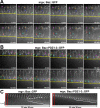Displacement of basolateral Bazooka/PAR-3 by regulated transport and dispersion during epithelial polarization in Drosophila
- PMID: 23015757
- PMCID: PMC3496619
- DOI: 10.1091/mbc.E12-09-0655
Displacement of basolateral Bazooka/PAR-3 by regulated transport and dispersion during epithelial polarization in Drosophila
Abstract
Polarity landmarks guide epithelial development. In the early Drosophila ectoderm, the scaffold protein Bazooka (Drosophila PAR-3) forms apicolateral landmarks to direct adherens junction assembly. However, it is unclear how Bazooka becomes polarized. We report two mechanisms acting in concert to displace Bazooka from the basolateral membrane. As cells form during cellularization, basally localized Bazooka undergoes basal-to-apical transport. Bazooka requires its three postsynaptic density 95, discs large, zonula occludens-1 (PDZ) domains to engage the transport mechanism, but with the PDZ domains deleted, basolateral displacement still occurs by gastrulation. Basolateral PAR-1 activity appears to act redundantly with the transport mechanism. Knockdown of PAR-1 sporadically destabilizes cellularization furrows, but basolateral displacement of Bazooka still occurs by gastrulation. In contrast, basolateral Bazooka displacement is blocked with disruption of both the transport mechanism and phosphorylation by PAR-1. Thus Bazooka is polarized through a combination of transport and PAR-1-induced dispersion from basolateral membranes. Our work complements recent findings in Caenorhabditis elegans and thus suggests the coupling of transport and dispersion is a common protein polarization strategy.
Figures




Similar articles
-
Interactions between the PDZ domains of Bazooka (Par-3) and phosphatidic acid: in vitro characterization and role in epithelial development.Mol Biol Cell. 2012 Sep;23(18):3743-53. doi: 10.1091/mbc.E12-03-0196. Epub 2012 Jul 25. Mol Biol Cell. 2012. PMID: 22833561 Free PMC article.
-
A Par-1-Par-3-Centrosome Cell Polarity Pathway and Its Tuning for Isotropic Cell Adhesion.Curr Biol. 2015 Oct 19;25(20):2701-8. doi: 10.1016/j.cub.2015.08.063. Epub 2015 Oct 8. Curr Biol. 2015. PMID: 26455305
-
Rap1 acts via multiple mechanisms to position Canoe and adherens junctions and mediate apical-basal polarity establishment.Development. 2018 Jan 26;145(2):dev157941. doi: 10.1242/dev.157941. Development. 2018. PMID: 29361565 Free PMC article.
-
Novel insights into epithelial polarity proteins in Drosophila.Trends Cell Biol. 2011 Jul;21(7):401-8. doi: 10.1016/j.tcb.2011.03.005. Epub 2011 Apr 27. Trends Cell Biol. 2011. PMID: 21530265 Review.
-
E-cadherin-mediated adhesion is not the founding event of epithelial cell polarity in Drosophila.Trends Cell Biol. 2005 May;15(5):237-40. doi: 10.1016/j.tcb.2005.03.001. Trends Cell Biol. 2005. PMID: 15866027 Review.
Cited by
-
Scribble and Discs-large direct initial assembly and positioning of adherens junctions during the establishment of apical-basal polarity.Development. 2019 Nov 21;146(22):dev180976. doi: 10.1242/dev.180976. Development. 2019. PMID: 31628110 Free PMC article.
-
Identification of ceRNA networks in type H and L vascular endothelial cells through integrated bioinformatics methods.Zhong Nan Da Xue Xue Bao Yi Xue Ban. 2024 Apr 28;49(4):562-577. doi: 10.11817/j.issn.1672-7347.2024.230343. Zhong Nan Da Xue Xue Bao Yi Xue Ban. 2024. PMID: 39019785 Free PMC article.
-
A Single-Cell Biochemistry Approach Reveals PAR Complex Dynamics during Cell Polarization.Dev Cell. 2017 Aug 21;42(4):416-434.e11. doi: 10.1016/j.devcel.2017.07.024. Dev Cell. 2017. PMID: 28829947 Free PMC article.
-
Par-1 controls the composition and growth of cortical actin caps during Drosophila embryo cleavage.J Cell Biol. 2019 Dec 2;218(12):4195-4214. doi: 10.1083/jcb.201903152. Epub 2019 Oct 22. J Cell Biol. 2019. PMID: 31641019 Free PMC article.
-
Rap1 and Canoe/afadin are essential for establishment of apical-basal polarity in the Drosophila embryo.Mol Biol Cell. 2013 Apr;24(7):945-63. doi: 10.1091/mbc.E12-10-0736. Epub 2013 Jan 30. Mol Biol Cell. 2013. PMID: 23363604 Free PMC article.
References
-
- Bayraktar J, Zygmunt D, Carthew RW. Par-1 kinase establishes cell polarity and functions in Notch signaling in the Drosophila embryo. J Cell Sci. 2006;119:711–721. - PubMed
-
- Benton R, St Johnston D. A conserved oligomerization domain in Drosophila Bazooka/PAR-3 is important for apical localization and epithelial polarity. Curr Biol. 2003a;13:1330–1334. - PubMed
-
- Benton R, St Johnston D. Drosophila PAR-1 and 14-3-3 inhibit Bazooka/PAR-3 to establish complementary cortical domains in polarized cells. Cell. 2003b;115:691–704. - PubMed
-
- Bohm H, Brinkmann V, Drab M, Henske A, Kurzchalia TV. Mammalian homologues of C. elegans PAR-1 are asymmetrically localized in epithelial cells and may influence their polarity. Curr Biol. 1997;7:603–606. - PubMed
-
- Doerflinger H, Benton R, Shulman JM, St Johnston D. The role of PAR-1 in regulating the polarised microtubule cytoskeleton in the Drosophila follicular epithelium. Development. 2003;130:3965–3975. - PubMed
Publication types
MeSH terms
Substances
LinkOut - more resources
Full Text Sources
Molecular Biology Databases
Research Materials

